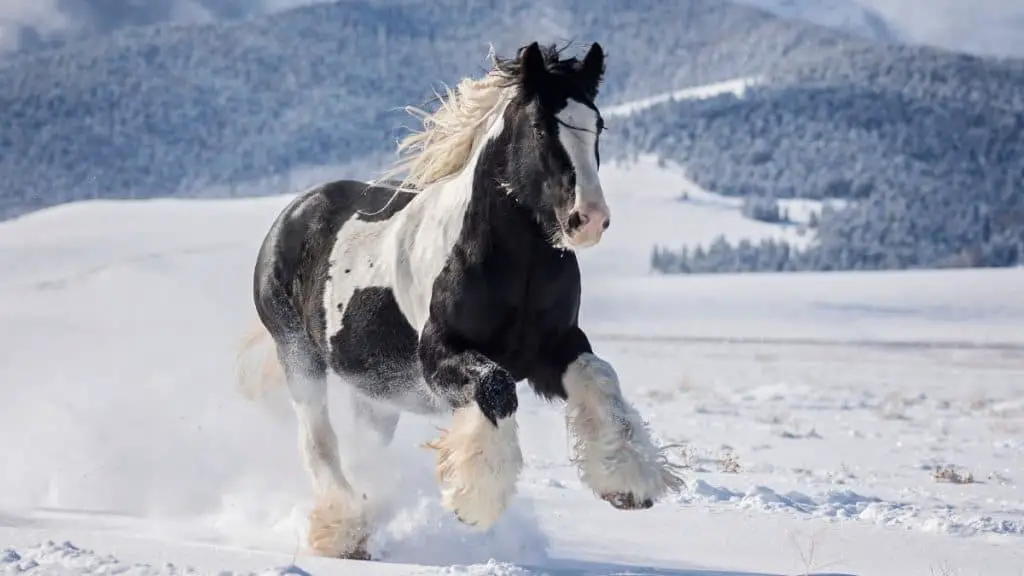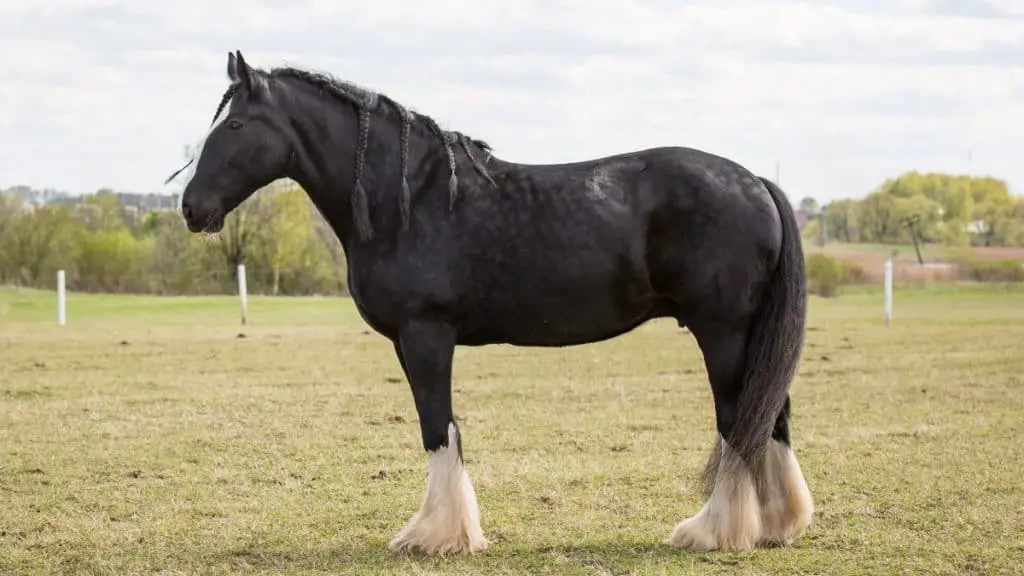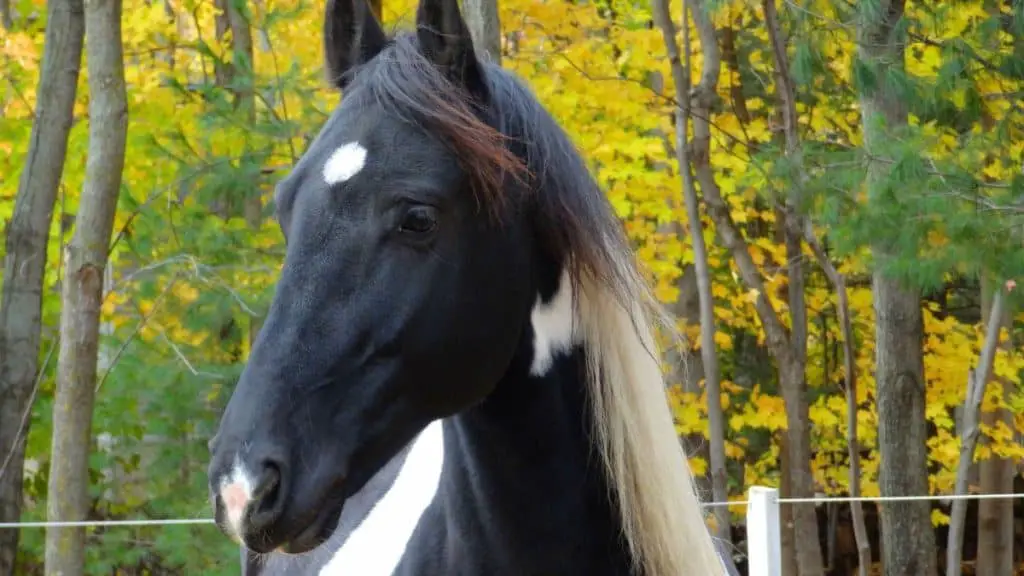Black and white horses certainly stand out for their sophisticated looks. But black and white coat colorings are relatively uncommon. Uncommon though it is, many breeds produce this coat coloration, such as the Gypsy Vanner or Appaloosa.
Horses that do produce black and white coloration have either overo, painted, tobiano, piebald or spotted patterns on their coats. If those names sound confusing to you, don’t worry, we’ll go over each of them in the article below.
There are endless variations in horse coat colors and patterning, and, despite its rarity, many breeds can produce black and white coat coloring.
There are also some breeds listed in this article that are sure to surprise you.
Let’s look at some of the most common black and white horse breeds producing black and white coat colors.
What Horse Breeds Produce Black And White Coats?
Many horse breeds can produce black and white coloration, from Appaloosa, in which it is relatively common, to Morgans, in which it is less common. Let’s learn a bit about each of these breeds.
1. Gypsy Vanner

Sometimes referred to as the Gypsy Horse, Irish Cob, or Galineers Cob, the Gypsy Vanner is a domestic horse originating in Britain and Ireland. It is a smaller, solidly built cob horse with skewbald or piebald patterns and is commonly black and white.
Characterized by its long feathered legs and luscious manes and tails, the Gypsy Vanner is known for its ability to grow a mustache. They get their names because, during the mid 19th century, traveling gypsies used this particular breed to pull their wagons.
Although equestrians of every ability are known to enjoy driving these horses, these horses are ideal for the beginner.
2. American Paint Horse
Combining western stock horse characteristics with white and dark pinto spotting, the American Paint Horse is one of the most common horses in North America.
Black and white are common color combinations of the painted horse, and their spots can be any size or shape, except for the leopard complex spotting characteristic of Appaloosa’s. The most common coat patterns include overo, tovero, and tobiano.
Some Paint Horses with solid colors can be registered, but the vast majority have paint markings of a contrasting, solid white area over a predominant hair color. Succeding in both Western and English disciplines, these colorful horses are beautiful and flashy.
3. Appaloosa

One of the most recognizable breeds of horse, Appaloosas have incredibly eye-catching coats of spotted hair. Snowflake, leopard, and blanket are the most common patterns, and black and white are standard coat colors, although many colors are possible.
Appaloosas have lovely, friendly demeanors, which makes them great family horses. They also excel in both English and Western disciplines and have long been bred for the athletic abilities, as well as their unique coat colors.
Although multiple breeds have influenced these horses throughout their history, this particular breed traces its roots back to prehistoric times. Horses with leopard spotting have been found on cave paintings and prehistoric art throughout Europe, Asia, and North America.
4. Pony Of The Americas
With their gentle temperaments and unique coats, the Pony of the Americas makes for a marvelous children’s pony. The leopard coloring of their coats, which is frequently black and white, comes from their genetic relation to the Appaloosa horse, although they are also related to Shetlands and Arabians.
The breed first appeared in the state of Iowa, with the first breed registries founded in 1954. It was bred primarily for Western riding, although it is often used in driving, endurance riding, and some English disciplines.
5. American Saddlebred
Known as the ‘horse America made,’ American Saddlebred’s are stars of the show ring. Black and white pinto is an uncommon coloration for this breed, but it is not rare. These flashy horses can also come in colors including bay, chestnut, and black.
Versatile horses, the American Saddlebred is known for competing in saddle seat divisions, though they are also proficient in dressage and jumping.
6. Morgan
One of the earliest breeds of horse developed in the U.S., Morgans are typically chestnut, black, or bay, but some have overo patterns of black and white hairs. These horses are lovely, graceful mounts and have gentle temperaments.
Able to compete in saddle seat, jumping, dressage, endurance, and Western disciplines, the Morgan is a versatile horse. They also make for fantastic trail, work, and pleasure horses.
Their breed registry was established in 1909, and there are an estimated 175,000 Morgan horses in the world. The Morgan is the state horse of Rhode Island and Massachusetts.
7. Mustang
Mustang horses are national treasures, symbols of the American West. Sometimes these lovely horses can be seen with pinto coats of black and white, although it is a less common coloration for this breed.
In the United States, the Bureau of Land Management (BLM) is responsible for rounding these beauties up each year to control their population. The BLM offers the excess population of Mustangs for adoption where, with proper training, they can become excellent trail mounts.
Originally the Mustangs were the horses of the Spanish colonists. As a result, many breeds contributed to the modern mustang. Some of these free-roaming mustangs are almost entirely unchanged from the original stocks from which they came. On the other hand, others have changed considerably.
In 2017 the population was estimated to be just over 72,000 horses in the wild.
8. Knabstrupper

The Knabstrupper is a warmblooded Danish breed with an extensive range of coat colors. Ranging from solid to full leopard-spotted coats to everything in between, this breed is frequently seen with a white base coat and black spotting.
Their well-proportioned necks, expressive heads, and strong backs make them especially good for eventing, show jumping, or dressage. Their unique, Dalmation-like coats have made them a popular breed since they first were established in 1812.
9. Miniature Horse
A result of selective breeding, Miniature horses are friendly fellows often kept as family pets. These adorable animals are among the shortest horse breeds in the world, and they come in a variety of colorations and patterns, including black and white pinto.
Miniature horses are bred to be scaled-down versions of regular-sized light horses. Thus, unlike a pony, they are the same proportions as a regular horse. Standing between 34-38 inches or under, Miniature horses have some long-term health issues associated with their sizes.
First developed in the 1600s, by the late 18th-century miniature horses were frequently seen as pets of the nobility throughout Europe. In England, they were used in mines as pit ponies.
10. Shetland Pony
The precocious Shetland pony is a popular driving pony, particularly for youth or small children just beginning to learn how to ride.
Standing a mere 42 inches tall, Shetlands are well-rounded, hardy ponies once used in coal mines as pit ponies. Now they are used as companions or for showing, harness driving, or trained as guide horses.
Originating in the northern Scottish islands of Shetland, these ponies have heavy coats, short legs and can come in a variety of colorations, including black and white. They have muscular bodies, strong legs, widely spaced eyes, and a deep girth.
11. Tennessee Walking Horse
Known for its running walk, the Tennessee Walking horse is beloved by riders everywhere. They have flashy movements and a unique four-beat gait and come in various colors, including black and white overo and tobiano.
The breed was first developed in the late 18th century by crossing several pacer breeds with Spanish Mustangs. Black Allan is the foundation sire of the entire breed.
These elegant horses are tall with long necks and small, well-placed ears, and they are found in several colors and patterns. Tennessee Walking Horses are known for their calm dispositions and prized for their smooth-riding gait.
12. Icelandic Horse
Long treasured by the Icelandic people and most famous for their flying pace gait, these horses are known for their vibrant colors and patterns. There are many examples of black and white pinto Icelandic horses.
Popular mounts for both adults and children alike, these small, sturdy horses are a hardy breed made to survive the harsh winters of Iceland. Despite their rugged nature, they have friendly personalities that make them excellent companions.
Traditionally used for sheepherding work, they are still often used for these purposes in their native Iceland. Icelandic law does not allow horses to be imported into their country, nor are exported horses permitted to return. This prevents diseases from spreading amongst its population.
13. Shire

This British breed of draught horse is typically black, grey, or bay, but the breed sometimes produces black and white coloration in various patterns.
Shire horses are the largest breed of horse. It was traditionally used in farm work or as cart horses. The breed was first established in the mid-1700s, with the first breed society forming in the 1870s.
Due to their usefulness as a working horse, there were a huge number of shire horses existing until the mid 20th century when the need for draught horses rapidly decreased. It is now considered an at-risk breed, with only an estimated 600 alive today.
14. Friesian

Black and white pinto Friesian horses are very rare. Most commonly, Friesians with pinto patterning are not true Friesians and would not be accepted as breeding stock. Typically Friesians have black coats, but occasionally they are chestnut and bay.
These beautiful horses originated in the Netherland region of Friesland. They are eminently graceful and nimble for their large size. Once upon a time, they were used as war horses throughout Europe. Their large size enabled them to carry a knight laden with armor.
Today the Friesian horse is popular, expensive, and strictly controlled by their representative breeding societies. Usually, they are used as both driving and riding horses but are also gaining popularity in the dressage.
What Are The Coat Patterns Of Black And White Horses?
There are several coat patterns black and white horses can come. Let’s take a look at each of them.
1. Spotted
Sometimes the spotted coat color is mistermed ‘appaloosa,’ but it is more appropriate to use this term to refer to the Appaloosa breed.
Each spotted horse is unique in terms of patterning and coloration. Black and white is a common coloration of spotting, but many color combinations are possible.
Several distinct patterns characterize the spotted coat pattern:
- Leopard Spot: a white horse with evenly distributed spots of any color.
- Near Leopard: similar to the above with colored head and legs only.
- Spotted Blanket: mainly colored with white-spotted hindquarters or back.
- White Blanket: mainly colored with hindquarters and/or back without spots.
- Snowflake: colored with white spots all over.
- Frosted Hip/Frosted Blanket: colored with white spots or frosting on hips/loin.
- Marble: colored at birth, roans with age to a marbled almost-white.
- Few Spot Leopard: White with only a few spots.
2. Overo
A white coat pattern that is often combined with black, although it can be any color. Typically the overo pattern is characterized by white originating on the belly, with white ‘blotches’ or ‘splashy’ coloration on its back, face, or hooves.
Overo rarely extends across the back of the horse to its withers or tail.
3. Piebald
A black horse that has a white tobiano or overo pattern, the piebald pattern can also have both patterns at once. This is called ‘tovero.’
The amount of black and white patches can vary enormously between horses. The pattern on each horse is unique.
4. Tobiano
A white coat pattern combined with another color, sometimes black. Typically this manifests in a colored head. Unlike the Overo coloration, tobiano patterns have distinct edges rather than jagged.
Some color crosses over the back and is present on both flanks. The head is typically colored, although it may have a stripe, blaze, star, or snip. All four of the horse’s legs will be white.
Conclusion
Black and white horses come from many different breeds and have many different patterns. It is a rarer coloration, most commonly found in the Appaloosa breed. Beautiful black and white horses are highly desirable, especially in breeds where these colors are rarest.
